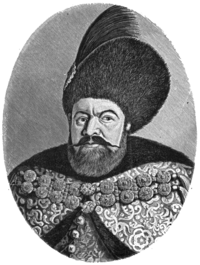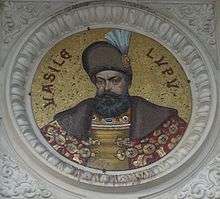Vasile Lupu

Lupu Coci, known as Vasile Lupu (Romanian pronunciation: [vaˈsile ˈlupu]; 1595–1661) was the Voivode of Moldavia between 1634 and 1653. Lupu had secured the Moldavian throne in 1634 after a series of complicated intrigues and managed to hold it for twenty years. Vasile was a capable administrator and a brilliant financer and was soon almost the richest man in the Christian East. His gifts to Ottoman leaders kept him on good terms with the Ottoman authorities.
Early life
Lupu's origin is unclear. The Coci family settled in Wallachia (Țara Rumânească) in the first half of the 16th century.[1] His father, Nicolae (Neculai) Coci was a shopkeeper from Macedonia, the son of Constantin (Coce) and Ecaterina.[2] Nicolae entered Moldavian nobility in 1593.[3] According to some sources, his father was born in Arbanasi (a village in modern Bulgaria), while some other historians claim Arbănaşi (modern Romania).[4]
Dimitrie Cantemir (1673–1723) called him Albanezul ("Albanian"); some historians maintain that Lupu's father, Neculai, was of Albanian origin.[5] Nicolae Bănescu (writing in 1926) maintained that his father was of Balkanic origin, while his mother was Romanian (Moldavian).[6] Seton-Watson (writing in 1934) mentioned him as being of Albanian origin.[7] English historian Steven Runciman (1903–2000) maintains that his father was an Albanian adventurer, and his mother was a Moldavian heiress.[8] According to historian Ioan Bolovan (1997), Vasile Lupu's father was an Albanian from Arbanasi, probably with distant origin from Epirus.[9] According to historian Toader Nicoară (2005), he may have been an Albanian from Arbanasi, Bulgaria.[10] In modern historiography, his descent has been described as of mixed Albanian and Greek origin.[11]
He received Greek education.[12]
Reign

Lupu had held a high office under Miron Barnovschi, and was subsequently selected Prince as a sign of indigenous boyars' reaction against Greek and Levantine competition. This was because Vasile Lupu had led a rebellion against Alexandru Iliaş and his foreign retinue, being led into exile by Moise Movilă (although he was backed by Prince Matei Basarab and the powerful Pasha of Silistra, Mehmet Abza). Despite having led the rebellion against Greek influence, Lupu maintained strong ties to the Greeks and the Patriarchate of Constantinople.[13] He pursued a Greek-Orthodox policy and sought to become the new Byzantine Emperor.
His rule was marked by splendor and pomp. He was a builder of notable monuments (the unique Trei Ierarhi Monastery in Iaşi and the St. Paraskeva Church, Lviv, among others), a patron of culture and arts (introducing printing presses, founding the Academia Vasiliană upper school - that was to last, as the "Şcoala mare domnească", until 1821). These acts also had negative effects, the tax burdens being increased to an intolerable level.
After relations between the two Princes soured, Vasile Lupu spent much of his reign fighting the Wallachian Matei Basarab, trying to impose his son Ioan to the throne in Bucharest. His army was defeated twice in 1639 at Ojogeni and Nenişori and a third time, at Finta, in 1653. After this last battle, the Moldavian boyars rebelled and replaced him with the Wallachian favorite, Gheorghe Ştefan. Vasile Lupu went into exile and died while being kept in Turkish custody at Yedikule prison in Constantinople.
Lupu built a strong alliance with hetman Bohdan Khmelnytsky, arranging the marriage of his own daughter Ruxandra to Khmelnytsky's son Tymofiy (Tymish), who went on to fight alongside Lupu at Finta.
Laws and reforms
Vasile Lupu introduced the first codified printed law in Moldavia, the Carte Româneascǎ de învăţătură ("Romanian book of learning", 1646, published in Iaşi), known as the Pravila lui Vasile Lupu ("Vasile Lupu's code").[14] The document follows Byzantine tradition, being a translated review of customs and almost identical to its Wallachian contemporary equivalent.
Endowments
Lupu founded churches and monasteries throughout his lands. The liturgical language was described as "vulgar Greek" by Robert Bargrave who travelled the lands.[15]
Education
Lupu founded the Princely High School of Trei lerarhi Church in 1640, which taught in Greek and Latin.[16]
Family
The Coci last name was carried on by Stefan Coci (son of Vasile Lupu) who married the daughter of Petru Rareş, a voivode of Moldavia, but also by the descendant of Gabriel Coci named Hatmanul. The descending line of Coci intersects with aristocratic families from Moldavia, old families such as the Bucioc, Boulesti, and Abazesti.
See also
References
- ↑ Revista istorică. Editura Academiei Române. 1993.
Vasile Lupu se trage din familia Coci, venită în Ţările Române încă din prima jumătate a secolului al XVI-lea, era al treilea fiu al lui Nicolae Coci, ...
- ↑ Mihail-Dimitri Sturdza (2004). Familiile boierești dîn Moldova și Țara Românească: Abaza-Bogdan. Simetria.
NICOLAE COCI Negustor macedonean, fiul unui Coce (Constantin) şi al Ecaterinei
- ↑ Constantin Şerban (1991). Vasile Lupu. Editura Academiei Române. ISBN 978-973-27-0205-5.
Tot atît de sigur este faptul că Nicolae Coci a fost mare comis în Moldova (martie- aprilie 1593), pe timpul lui Aron vodă Tiranul, că apoi a trecut în Ţara Românească, unde a fost mare postelnic (octombrie 1593 — 22 iulie 1594) , apoi din nou ...
- ↑ Nicolae Ciachir (2003). Un istoric român ancorat în lumea contemporanâ. Oscar Print. ISBN 978-973-668-014-4.
- ↑ Demir Dragnev (2006). Civilizația medievală și modernă în Moldova: studii : în honorem Demir Dragnev. Civitas. p. 435. ISBN 978-9975-912-54-9.
- ↑ Nicolae Bănescu (1926). Historical survey of the Rumanian people. Cvltvra nationala. p. 35.
- ↑ R. W. Seton-Watson (21 May 2015) [1934]. A History of the Roumanians. Cambridge University Press. pp. 74–. ISBN 978-1-107-51158-3.
- ↑ Runciman 1985, p. 341.
- ↑ Ioan Bolovan (1997). A History of Romania. Center for Romanian Studies. p. 287.
Voivode of Moldavia was an Albanian from Arbanasi, probably with distant origin from Epirus, a region of mixed population. The majority of the population of the famous region is Greek and Albanian, but there live also thousands of "real Epirotes", the Romanian-speaking Vlachs of Pindus. This has served as a base for fabrications according to which Lupu was a Greek or a Vlach (Aromanian). Some Romanian historians explain that Epirote Vlachs are in fact Romanians and for this reason it is claimed Lupu was a Romanian. However, the most interesting fabrication is that Lupu was a Bulgarian because his father lived in Arbanasi, which today is part of Bulgaria.
- ↑ Toader Nicoară (2005). Sentimentul de insecuritate în societatea românească la începuturile timpurilor moderne 1600-1830. Accent. ISBN 978-973-8445-08-6.
Nicolae Coci, arnăut din Arvanitohori, lângă Târnovo
- ↑ Entangled Histories of the Balkans: Volume One: National Ideologies and Language Policies. BRILL. 13 June 2013. pp. 94–. ISBN 978-90-04-25076-5.
- ↑ Richard C. Frucht (2005). Eastern Europe: an introduction to the people, lands, and culture. ABC-CLIO. pp. 750–. ISBN 978-1-57607-800-6.
Lupu, an ambitious politician of Albanian origin and Greek education
- ↑ Călin Hentea (2007). Brief Romanian Military History. Scarecrow Press. p. 76. ISBN 978-0-8108-5820-6.
- ↑ Susana Andea (2006). History of Romania: compendium. Romanian Cultural Institute. p. 332. ISBN 978-973-7784-12-4.
In the legislative field, he managed to print the Imperial Code of Laws in 1646 (Vasile Lupu's Code, or the Romanian Book of Learning).
- ↑ Robert Bargrave (1 January 1999). The Travel Diary of Robert Bargrave: Levant Merchant (1647-1656). Hakluyt Society. p. 136. ISBN 978-0-904180-63-3.
- ↑ Allen Kent; Harold Lancour; Jay E. Daily (1 February 1979). Encyclopedia of Library and Information Science: Volume 26 - Role Indicators to St. Anselm-College Library (Rome). CRC Press. pp. 65–. ISBN 978-0-8247-2026-1.
Sources
- Runciman, Steven (1985). The Great Church in Captivity: A Study of the Patriarchate of Constantinople from the Eve of the Turkish Conquest to the Greek War of Independence. Cambridge University Press. pp. 286–7, 341–3, 370. ISBN 978-0-521-31310-0.
- George Ioan Brătianu (1995). Sfatul domnesc şi adunarea stărilor în principatele române. Editura Enciclopedică. ISBN 978-973-45-0096-3.
- N.Jorga "Byzance apres Byzance, pp. 163–181
| Preceded by Moise Movilă |
Prince/Voivode of Moldavia April 1634–April 1653 |
Succeeded by Gheorghe Ştefan |
| Preceded by Gheorghe Ştefan |
Prince/Voivode of Moldavia May–June 1653 |
Succeeded by Gheorghe Ştefan |
| Wikimedia Commons has media related to Vasile Lupu. |